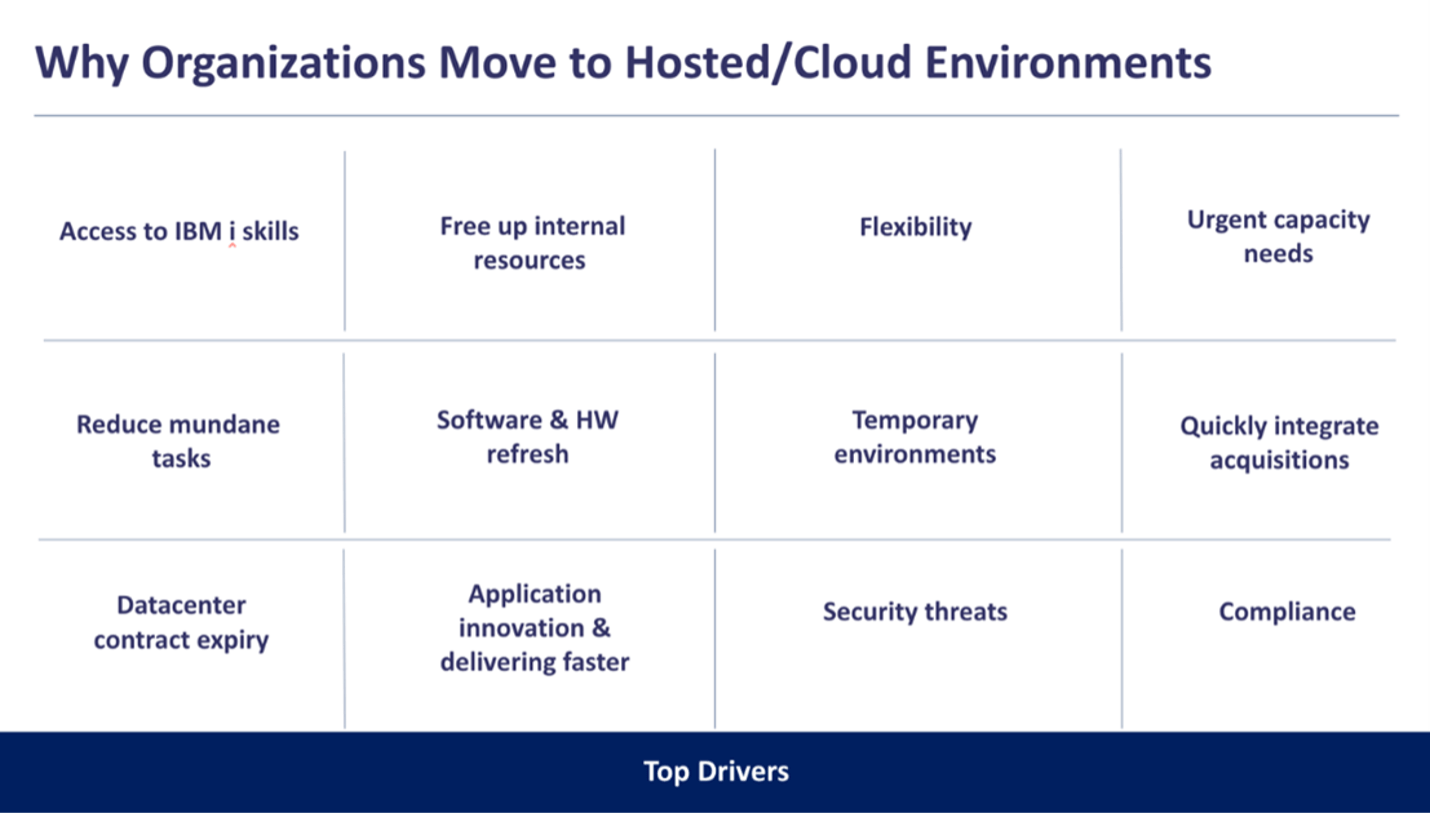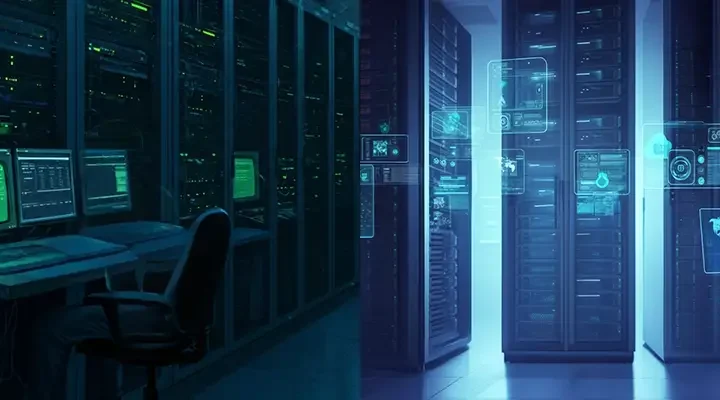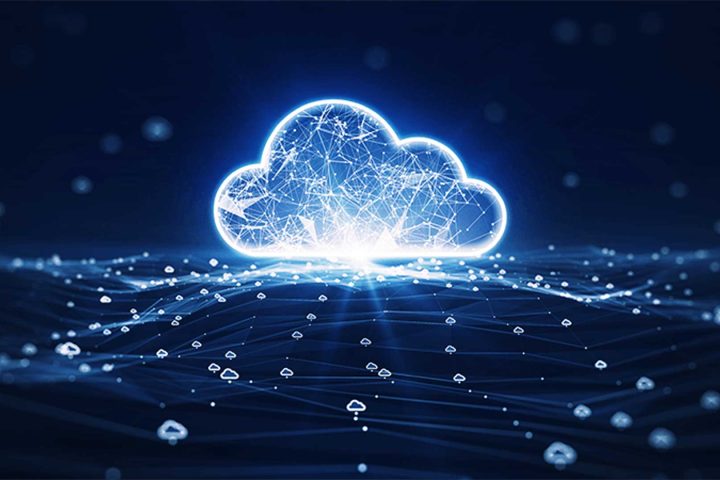
In the last couple of years, nudged by internal and external factors, companies across industries are upgrading or looking to implement new workload models to run business-critical IBM i applications. As you consider a tech refresh or a move to Power 10, think about what the ideal workload model aka where to run which applications.
Decisions to upgrade infrastructure are historically based on how much the business is expected to grow in the next few years and figuring out how much processing & storage capacity you might need to accommodate said growth.
But that might not be the most efficient way to determine when to get your next box – not only is the world more complex, full of market changes, there are also more cost-effective and efficient options available to you. Just because you have run on-premise systems for decades, doesn’t mean you have to continue to do that. But running hardware is likely not core to what your business does every day, even if the applications are.
To get everything done in the IT organization, re-evaluate the applications that you run and where you run them – it’s important to question everything you are doing in your datacenter:
- Do you have personnel who are potentially retiring soon?
- Do you need separate Dev/Test, UAT, production, and disaster recovery environments?
- Do you have reliable cybersecurity resources to safeguard your environment?
- Does your infrastructure design make sense in terms of where your servers are and the access to them?
- Are your systems and environments set up to be compliant?
- Will you have the resources to manage the infrastructure and its applications and keep the machine up to date?
- Do you need scalability on demand to support more remote employees than you did pre-pandemic?
We can all agree on our love for IBM Power Systems in 2025, but friends don’t let friends buy hardware they don’t need – before deciding to upgrade to Power9 or Power10 systems, consider your options and the value you can derive from cloud and managed services.

Why DO organizations move to hosted/cloud environments?
The IBM i platform has been around for over 35 years – many businesses have an aging workforce and are experiencing a skills gap – this is one of the primary reasons that organizations move.
Partnering with managed services providers is a great way to bridge the skills gap while also not fully committing to cloud – these providers engage a young workforce with expertise in IBM i and modern technologies, while retaining experienced people to inform direction.
Furthermore, in most IBM i shops, employees are responsible for the system day-to-day, which can be time consuming and menial. Working with managed service providers can free up internal resources to focus on developing core applications & databases to drive business growth.
When you are buying on-premise hardware or hiring a new employee, you are buying capacity that you think you will need in the future – chances are you’re overspending because your growth prediction is usually only an estimate.
Either that, or you’re overprovisioning your people, so the mundane system management tasks get done alongside critical application & database development. When you’re running in the cloud and using managed services to support your systems and applications, you only buy what you use.
Cloud & managed service providers like Fresche can free you from the burden and hassle of hardware and software refresh cycles, every couple of years. We are constantly refreshing our infrastructure, so you have access to the latest hardware. We can also set up Test/Dev environments, quality assurance environments, HA/DR systems, or handle backups and archives, ensuring that you have everything you need.
Cloud & managed service providers like Fresche can free you from the burden and hassle of hardware and software refresh cycles, every couple of years. We are constantly refreshing our infrastructure, so you have access to the latest hardware. We can also set up Test/Dev environments, quality assurance environments, HA/DR systems, or handle backups and archives, ensuring that you have everything you need.
Thinking of moving IBM i to the cloud? Book a complimentary cloud readiness assessment with Fresche.
{Book a Consultation}
Refocusing Capex, Moving to Opex
Moving a significant portion of IT from capital to operational expenses is a compelling reason for customers to embrace cloud in 2023. Traditional hardware and systems software purchases require large upfront payments, but with cloud, you will have a clear and reliable monthly cost, with no nasty surprises.
With the increasing cost of leasing, opting for a new system may not be ideal, especially for IBM i systems – they don’t invest a lot of equity into these systems, which limits the availability of operating leases. You may have to opt for a capital lease, which CFOs usually tend to avoid like the plague.
Being Cloud Smart
If you’re moving your production environment to the cloud (or considering it!), work with IBM i experts such as Fresche who can help you invest in the right systems and maximize the value you stand to gain from virtualization.
It is also important to remember that transitioning to cloud is a gradual process. You must crawl and walk before you run – cloud might not be the best option for every business right away. Have the right conversations and leverage managed services for a solution that is best for your organization.
Moving to cloud can also feel like a massive leap, one that you might not be ready or have the resources for – on-premise and hybrid models are meant precisely for those businesses that aren’t quite ready to go fully cloud-based.
For example, hybrid cloud allows you to perform disaster recovery in the cloud, or keep your backups local and offsite, while keeping production on-premise until you’re ready to transition fully. Fresche’s cloud experts have decades of experience helping businesses across industries start small. The step-by-step approach is what helps you feel comfortable with the cloud because by the time you’re ready to move, you fully understand what to expect.
Consider this Responsibility Matrix – this should give you a better idea of where you are today and what your options are to make your IT & IBM i systems more agile and scalable.

If you are currently using on-premise solutions, you are responsible for managing all aspects of your IT infrastructure including applications, operations, network, connectivity, backups, hardware, and firmware. With an MSP such as Fresche, the team manages your on-site hardware, ensuring complete backups and disaster recovery in the cloud.
With a hybrid solution, the MSP can gradually assume more responsibilities, working in conjunction with your existing on-premise solutions. For a fully cloud-based solution, you won’t have to worry about hardware management, allowing you to focus on your business and its applications, which is where the focus of your IT department should be.
If you’re considering ways to best leverage cloud and managed services and the ideal workload model for your business, watch this roundtable session that I recently hosted called Let’s Talk IBM i Cloud with a group of industry experts.
Additionally, watch this on-demand session on Remote Managed Services and how companies are using it to streamline IBM i operations and costs, improve availability, and access expert IT skills to manage and secure their systems. Learn more and register here.
Let’s Talk Cloud?
Learn how Fresche Cloud can help you move your IBM i workloads to a secure, scalable cloud environment.
[Explore IBM i Cloud Solutions]
📞 1-800-361-6782
📧 info@freschesolutions.com
Frequently Asked Questions
Q1: Is IBM i cloud migration risky?
A: With the right planning and the right partner, moving IBM i workloads to the cloud can reduce risk by adding resilience, security, and modern scalability. Fresche’s experts can help you plan a gradual migration.
Q2: How long does it take to move IBM i to the cloud?
A: Timelines vary depending on your environment, but many customers start with hybrid models that can be implemented within weeks, then gradually expand to full cloud as needed.
Q3: How does IBM i performance compare in the cloud vs. on-prem?
A: Most customers see comparable or better performance in modern cloud environments, thanks to refreshed infrastructure and flexible capacity. Fresche uses the latest IBM Power hardware to support performance.
Q4: What are the cost benefits of moving IBM i to the cloud?
A: Cloud shifts spending from capital to operational expenses, eliminating hardware refresh cycles and providing predictable monthly costs.


